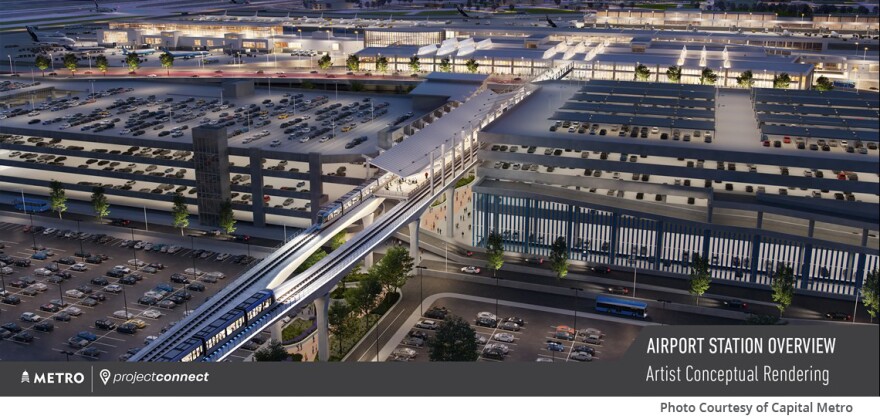The Austin Transit Partnership is unveiling its vision for the city's transit expansion: An almost 10-mile, on-street light-rail system that would reshape Austin's transit map and move 30,000 people per day. The recommendation comes after two and a half years of ups and downs for the voter-endorsed Project Connect.
After a six-week public engagement blitz, ATP selected its recommendation from five potential plans. This blueprint will now tour a circuit of public officials who will decide what actually gets built.

ATP's recommended light-rail plan is a significant detour from the initial promise to voters. At 9.8 miles, the revised map provides less than half the distance and a starkly reduced estimated ridership compared to the 2020 vision.
The new proposal trims major ambitions, including the $2 billion downtown subway that was dangled in front of voters with artist renderings showing underground shopping, dining and live music.

But ATP is heralding the recommended plan as the first phase of a grander vision. This leaner design helps sidestep a potential fiscal sinkhole after the original $5.8 billion price tag had ballooned to more than $10 billion due to inflation and design changes.
This new Project Connect milestone is being triumphantly unveiled Tuesday to the ATP board and Austin City Council against the backdrop of intensifying threats from state officials. Republican lawmakers and the Texas Attorney General are convinced Austin twisted state law to exploit a loophole in the power of local government to tax and borrow.
A bill promising to create new obstacles for ATP's borrowing authority has advanced almost to the desk of Gov. Greg Abbott. Compounding this uncertainty, a recent legal opinion by Texas Attorney General Ken Paxton raises concerns about the city's strategy for financing the transit system.
Paxton says the way the city is dedicating property taxes to ATP for financing up to $1.75 billion in bonds and loans likely violates state law and the Texas constitution. On Monday, state Sen. Paul Bettencourt modified House Bill 3899 — the one targeting ATP — to integrate Paxton's concerns, increasing roadblocks for Project Connect.
But ATP is still forging ahead.
The local government corporation's recommended plan calls for building a rail network that winds from 38th Street down Guadalupe, turns on Third Street downtown to reach the Austin Convention Center, pivots south on Trinity Street and leaps over Lady Bird Lake on a bridge yet to take shape.

Arriving at the south shore of Lady Bird Lake, the route would split at Waterfront Station — a stop that could blend into a large and densely populated development planned at the site of the old Austin American-Statesman building.
One line would cruise down South Congress Avenue to Oltorf Street, while the other would venture down Riverside Drive, finding its terminus at Yellow Jacket Lane next to a new Park and Ride and a proposed $1 billion maintenance hub.
ATP's recommended map includes a new term: "phase one priority extensions." These are highly demanded sections that could get built immediately if there's enough money left over in the $5 billion budget or if new cash becomes available.
One of the priority extensions would reach from Yellow Jacket to Austin-Bergstrom International Airport — providing an airport connection that ATP says was the single most demanded feature among the thousands of comments received over the public comment period.

The other priority extension would stretch from 38th Street to Lamar and Airport Boulevards, boosting ridership by connecting to the MetroRail station at Crestview.
The plan best reflects what people asked for during the public comment period, the agency's Executive Director Greg Canally said, because it provides at least some coverage in all three directions laid out in the 2020 plans — north, south and east.
"The number one thing we heard along the line was, 'Let's get moving on this,'" Canally said. "We believe this phase one [of] Austin light-rail really achieves that. It allows us to get moving on building a system that Austinites want."
Canally defended on-street light-rail as "the best solution for Austin," saying it's more accessible than elevated or underground rail and makes the system highly visible. On-street rail is also the least expensive option, allowing for greater overall distance.
Elevated rail ensures trains can travel faster than the speed of traffic, a key factor in luring riders. Building elevated lines downtown would have cost about a third more than street-level lines downtown, according to an ATP document.

Putting trains on street level would increase travel times downtown but "not by very much," ATP's Engineering and Construction Chief Lindsay Wood said, because of how traffic signals would be timed.
"When you get that green light to come out of the station, the train gets all green lights until it gets to the next station," Wood said. This type of "transit signal priority" would require coordinating with the city and could affect waiting times on cross streets, including in theory for CapMetro buses.
The details of the plan will be debated in the coming weeks by the three bodies overseeing Project Connect: the Austin City Council, Capital Metro's board of directors and the ATP board — which is missing one of its five voting members since the April resignation of transportation finance professional Tony Elkins.
Those governing boards will gather for a joint meeting June 6. That's when they're expected to make a final decision.
Correction: This story has been corrected to clarify a phase one priority extension would reach to Crestview Station, not North Lamar Transit Center.













